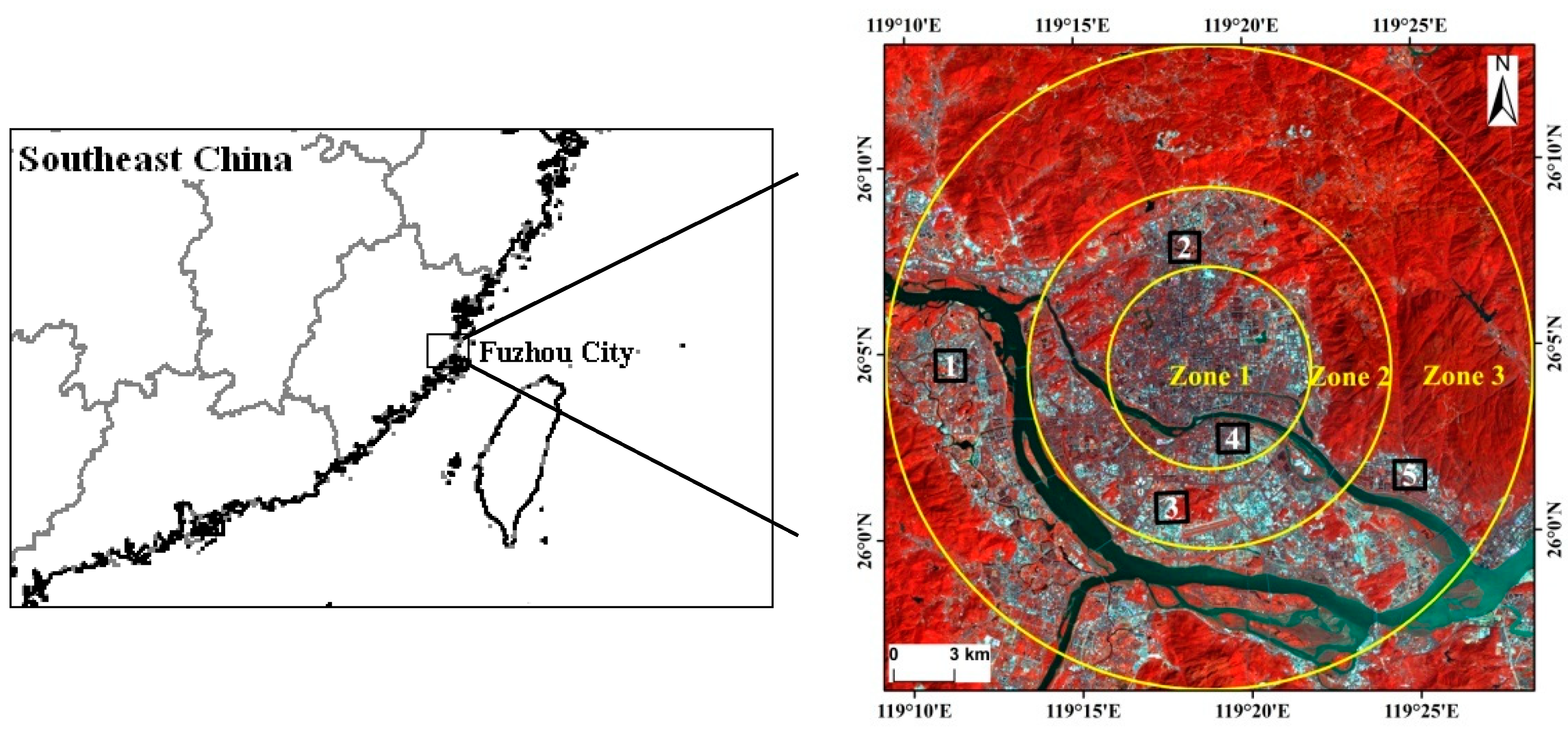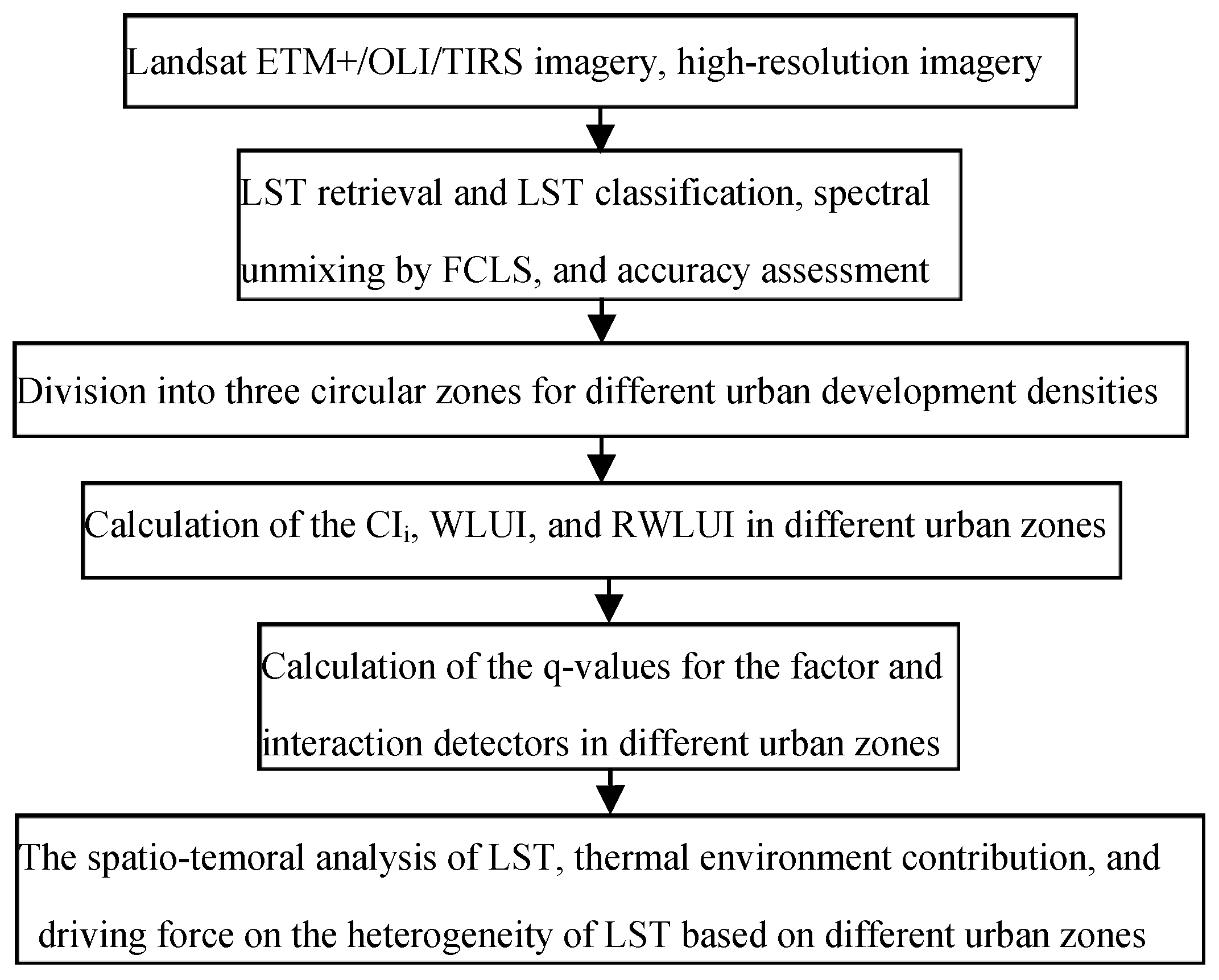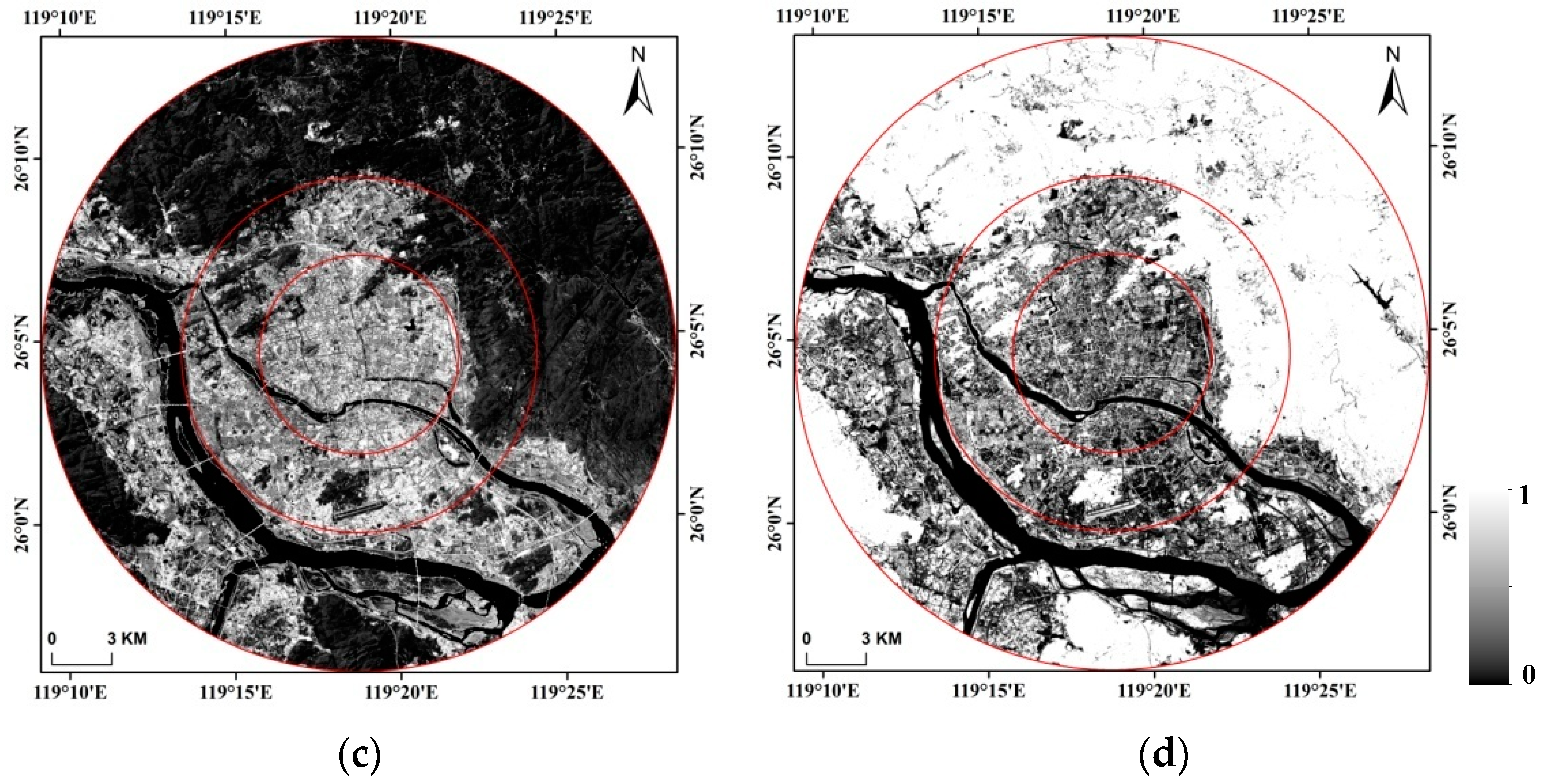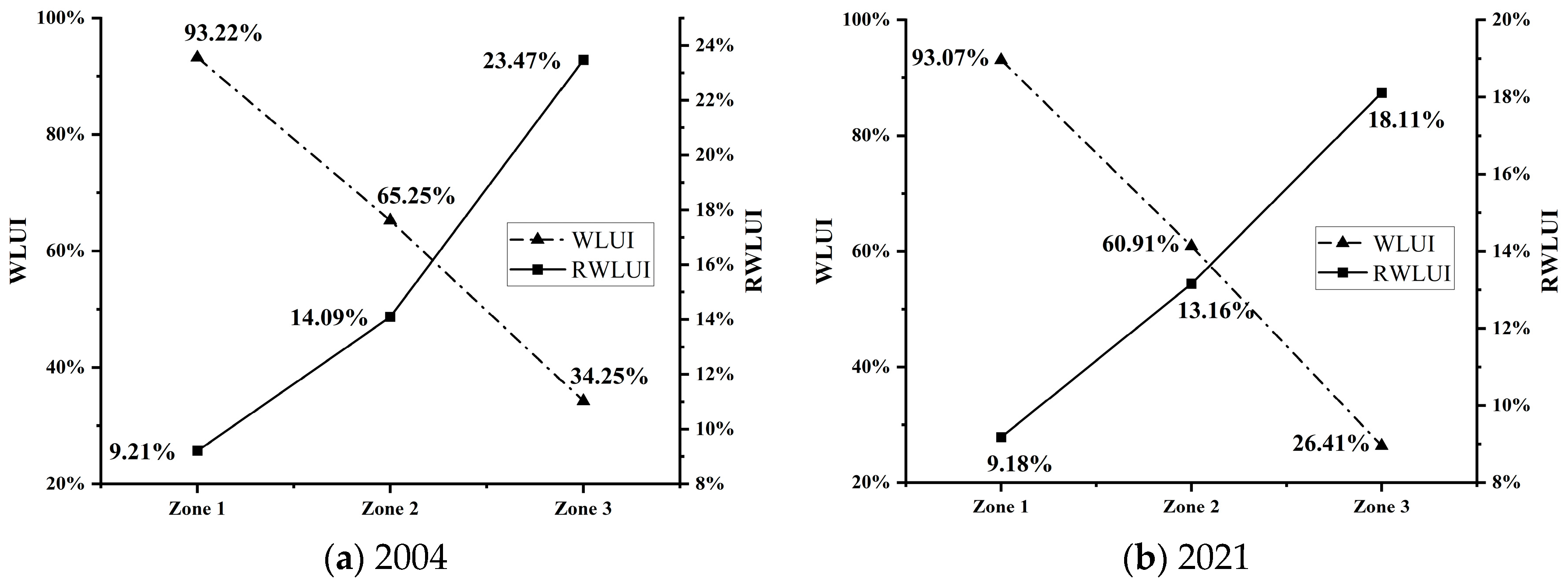Analyzing Thermal Environment Contributions and Driving Factors of LST Heterogeneity in Different Urban Development Zones
Abstract
1. Introduction
2. Materials and Methods
2.1. Study Area and Data
2.2. Methods
2.2.1. LST Retrieval and LST Classification
LST2: (LSTmean−2SD) < LST ≤ LSTmean
LST3: LSTmean < LST ≤ (LSTmean + 2SD)
LST4: LST > (LSTmean + 2SD)
2.2.2. Percent ISA and FVC Derived by Spectral Unmixing of Fully Constrained Least Squares and Accuracy Assessment
2.2.3. Calculation of Thermal Environment Contribution Based on Different Urban Zones
2.2.4. Spatial Statistical Analysis with Geographical Detector (Geodetector)
3. Results and Discussion
3.1. Analysis of the Spatial Pattern of LST in Different Urban Zones
3.2. Analysis of Thermal Environment Contribution in Each Urban Zone
3.3. Driving Force Detection of Spatial Heterogeneity of LST by Geodetector
4. Conclusions
- (1)
- ISA increase resulting from urban expansion mainly concentrated in the south and west areas of Zones 2 and 3 from 2004 to 2021, and the high and sub-high LST areas also mainly increased in Zone 2 and Zone 3 during the period.
- (2)
- The thermal environment contribution of Zone 3 significantly increased from 2004 to 2021. The CIi of Zones 2 and 3 reached over 89% in 2021, and the thermal environment contribution was determined and dominated by Zone 2 and Zone 3 in the study area in 2021.
- (3)
- In the study area, the driving factors affecting the spatial differentiation of LST are regionally different, and the influence degree of three factors on LST is weaker in Zone 1 than in Zones 2 and 3. Compared with a single factor, the interaction between different factors can increase the influence on LST.
- (4)
- The combined analysis of thermal environment contribution and Geodetector provides a suitable method to reveal the impact of the urban landscape pattern on the urban thermal environment and the driving mechanisms of LST heterogeneity. The analytic results can provide a deeper understanding of the mechanisms of the UHI and provide recommendations for mitigating UHI.
Author Contributions
Funding
Data Availability Statement
Acknowledgments
Conflicts of Interest
References
- Huang, X.; Wang, Y. Investigating the effects of 3D urban morphology on the surface urban heat island effect in urban functional zones by using high-resolution remote sensing data: A case study of Wuhan, Central China. ISPRS J. Photogramm. Remote Sens. 2019, 152, 119–131. [Google Scholar] [CrossRef]
- Zhang, Y.; Wang, X.; Balzter, H.; Qiu, B.; Cheng, J. Directional and Zonal Analysis of Urban Thermal Environmental Change in Fuzhou as an Indicator of Urban Landscape Transformation. Remote Sens. 2019, 11, 2810. [Google Scholar] [CrossRef]
- Hu, X.; Xu, H. A new remote sensing index for assessing the spatial heterogeneity in urban ecological quality: A case from Fuzhou City, China. Ecol. Indic. 2018, 89, 11–21. [Google Scholar] [CrossRef]
- Oke, T. Street design and urban canopy layer climate. Energy Build. 1988, 11, 103–113. [Google Scholar] [CrossRef]
- Parker, D.E. Urban heat island effects on estimates of observed climate change. Wiley Interdiscip. Rev. Clim. Chang. 2010, 1, 123–133. [Google Scholar] [CrossRef]
- Zhou, W.; Qian, Y.; Li, X.; Li, W.; Han, L. Relationships between land cover and the surface urban heat island: Seasonal variability and effects of spatial and thematic resolution of land cover data on predicting land surface temperatures. Landsc. Ecol. 2014, 29, 153–167. [Google Scholar] [CrossRef]
- Zhou, W.; Wang, J.; Cadenasso, M. Effects of the spatial configuration of trees on urban heat mitigation: A comparative study. Remote Sens. Environ. 2017, 195, 1–12. [Google Scholar] [CrossRef]
- Zhang, Y.; Odeh, I.; Han, C. Bi-temporal characterization of land surface temperature in relation to impervious surface area, NDVI and NDBI, using a sub-pixel image analysis. Int. J. Appl. Earth Obs. Geoinf. 2009, 11, 256–264. [Google Scholar] [CrossRef]
- Frazier, A.E.; Wang, L. Characterizing spatial patterns of invasive species using sub-pixel classifications. Remote Sens. Environ. 2011, 115, 1997–2007. [Google Scholar] [CrossRef]
- Du, J.; Xiang, X.; Zhao, B.; Zhou, H. Impact of urban expansion on land surface temperature in Fuzhou, China using Landsat imagery. Sustain. Cities Soc. 2020, 61, 102346. [Google Scholar] [CrossRef]
- Lu, D.; Weng, Q. Use of impervious surface in urban land-use classification. Remote Sens. Environ. 2006, 102, 146–160. [Google Scholar] [CrossRef]
- Owen, T.; Carlson, T.; Gillies, R. An assessment of satellite remotely sensed land cover parameters in quantitatively describing the climatic effect of urbanization. Int. J. Remote Sens. 1998, 19, 1663–1681. [Google Scholar] [CrossRef]
- Chen, X.; Zhao, M.; Li, P.; Yin, Z. Remote sensing image based analysis of the relationship between urban heat island and land use/cover changes. Remote Sens. Environ. 2006, 104, 133–146. [Google Scholar] [CrossRef]
- Alexander, C. Influence of the proportion, height and proximity of vegetation and buildings on urban land surface temperature. Int. J. Appl. Earth Obs. Geoinf. 2021, 95, 102265. [Google Scholar] [CrossRef]
- Zhang, Y.; Balzter, H.; Li, Y. Influence of Impervious Surface Area and Fractional Vegetation Cover on Seasonal Urban Surface Heating/Cooling Rates. Remote Sens. 2021, 13, 1263. [Google Scholar] [CrossRef]
- Cao, X.; Onishi, A.; Chen, J.; Imura, H. Quantifying the cool island intensity of urban parks using ASTER and IKONOS data. Landsc. Urban. Plan. 2010, 96, 224–231. [Google Scholar] [CrossRef]
- Klok, L.; Zwart, S.; Verhagen, H.; Mauri, E. The surface heat island of Rotterdam and its relationship with urban surface characteristics. Res. Conserv. Recycl. 2012, 64, 23–29. [Google Scholar] [CrossRef]
- Deng, C.; Wu, C. Estimating very high resolution urban surface temperature using a spectral unmixing and thermal mixing approach. Int. J. Appl. Earth Obs. Geoinf. 2013, 23, 155–164. [Google Scholar] [CrossRef]
- Berger, C.; Rosentreter, J.; Voltersen, M.; Baumgart, C.; Schmullius, C.; Hese, S. Spatio-temporal analysis of the relationship between 2D/3D urban site characteristics and land surface temperature. Remote Sens. Environ. 2017, 193, 225–243. [Google Scholar] [CrossRef]
- Zhang, Y.; Harris, A.; Balzter, H. Characterizing fractional vegetation cover and land surface temperature based on sub-pixel fractional impervious surfaces from Landsat TM/ETM+. Int. J. Remote Sens. 2015, 36, 4213–4232. [Google Scholar] [CrossRef]
- Zhang, Y.; Balzter, H.; Liu, B.; Chen, Y. Analyzing the Impacts of Urbanization and Seasonal Variation on Land Surface Temperature Based on Subpixel Fractional Covers Using Landsat Images. IEEE J. Sel. Top. Appl. Earth Obs. Remote Sens. 2017, 10, 1344–1356. [Google Scholar] [CrossRef]
- He, C.; Gao, B.; Huang, Q.; Ma, Q.; Dou, Y. Environmental degradation in the urban areas of China: Evidence from multi-source remote sensing data. Remote Sens. Environ. 2017, 193, 65–75. [Google Scholar] [CrossRef]
- Shen, H.; Huang, L.; Zhang, L.; Wu, P.; Zeng, C. Long-term and fine-scale satellite monitoring of the urban heat island effect by the fusion of multi-temporal and multi-sensor remote sensed data: A 26-year case study of the city of Wuhan in China. Remote Sens. Environ. 2016, 172, 109–125. [Google Scholar] [CrossRef]
- Peng, W.; Yuan, X.; Gao, W.; Wang, R.; Chen, W. Assessment of urban cooling effect based on downscaled land surface temperature: A case study for Fukuoka, Japan. Urban Clim. 2021, 36, 100790. [Google Scholar] [CrossRef]
- Han, S.; Hou, H.; Estoque, R.; Zhang, Y.; Shen, C.; Murayama, Y.; Pan, J.; Wang, B.; Hu, T. Seasonal effects of urban morphology on land surface temperature in a three-dimensional perspective: A case study in Hangzhou, China. Build. Environ. 2023, 228, 109913. [Google Scholar] [CrossRef]
- Guo, G.; Zhou, X.; Wu, Z.; Xiao, R.; Chen, Y. Characterizing the impact of urban morphology heterogeneity on land surface temperature in Guangzhou, China. Environ. Model. Softw. 2016, 84, 427–439. [Google Scholar] [CrossRef]
- Song, J.; Chen, W.; Zhang, J.; Huang, K.; Hou, B.; Prishchepov, A. Effects of building density on land surface temperature in China: Spatial patterns and determinants. Landsc. Urban. Plan. 2020, 198, 103794. [Google Scholar] [CrossRef]
- Boori, M.; Choudhary, K.; Paringer, R.; Kupriyanov, A. Spatiotemporal ecological vulnerability analysis with statistical correlation based on satellite remote sensing in Samara, Russia. J. Environ. Manag. 2021, 285, 112138. [Google Scholar] [CrossRef] [PubMed]
- Guo, L.; Liu, R.; Men, C.; Wang, Q.; Miao, Y.; Zhang, Y. Quantifying and simulating landscape composition and pattern impacts on land surface temperature: A decadal study of the rapidly urbanizing city of Beijing, China. Sci. Total Environ. 2019, 654, 430–440. [Google Scholar] [CrossRef] [PubMed]
- Liu, J.; Xu, Q.; Yi, J.; Huang, X. Analysis of the heterogeneity of urban expansion landscape patterns and driving factors based on a combined Multi-Order Adjacency Index and Geodetector model. Ecol. Indic. 2022, 136, 108655. [Google Scholar] [CrossRef]
- Li, X.; Li, W.; Middel, A.; Harlan, S.L.; Brazel, A.J.; Turner, B.L. Remote sensing of the surface urban heat island and land architecture in Phoenix, Arizona: Combined effects of land composition and configuration and cadastral–demographic–economic factors. Remote Sens. Environ. 2016, 174, 233–243. [Google Scholar] [CrossRef]
- Omurakunova, G.; Bao, A.; Xu, W.; Duulatov, E.; Jiang, L.; Cai, P.; Abdullaev, F.; Nzabarinda, V.; Durdiev, K.; Baiseitova, M. Expansion of Impervious Surfaces and Their Driving Forces in Highly Urbanized Cities in Kyrgyzstan. Int. J. Environ. Res. Public Health 2020, 17, 362. [Google Scholar] [CrossRef] [PubMed]
- Wang, J.; Ouyang, W. Attenuating the surface urban heat island within the local thermal zones through land surface modification. J. Environ. Manag. 2017, 187, 239–252. [Google Scholar] [CrossRef] [PubMed]
- Shi, T.; Hu, Z.; Shi, Z.; Guo, L.; Chen, Y.; Li, Q.; Wu, G. Geo-detection of factors controlling spatial patterns of heavy metals in urban topsoil using multi-source data. Sci. Total Environ. 2018, 643, 451–459. [Google Scholar] [CrossRef] [PubMed]
- Voogt, J.A.; Oke, T.R. Thermal remote sensing of urban climates. Remote Sens. Environ. 2003, 86, 370–384. [Google Scholar] [CrossRef]
- Barsi, J.; Schott, J.; Palluconi, F.; Hook, S. Validation of a web-based atmospheric correction tool for single thermal band instruments. In Earth Observing Systems X; Butler, J.J., Ed.; Paper 58820E; SPIE: Bellingham, WA, USA, 2005; Volume 5882. [Google Scholar]
- Sobrino, J.; Raissouni, N.; Li, Z. A comparative study of land surface emissivity retrieval from NOAA data. Remote Sens. Environ. 2001, 75, 256–266. [Google Scholar] [CrossRef]
- Van De Grienzd, A.; Owe, M. On the relationship between thermal emissivity and the normalized difference vegetation index for natural surfaces. Int. J. Remote Sens. 1993, 14, 1119–1131. [Google Scholar] [CrossRef]
- Chander, G.; Markham, B. Revised Landsat-5 TM radiometric calibration procedures and post calibration dynamic ranges. IEEE Trans. Geosci. Remote Sens. 2003, 41, 2674–2677. [Google Scholar] [CrossRef]
- Mitraka, Z.; Chrysoulakis, N.; Kamarianakis, Y.; Partsinevelos, P.; Tsouchlaraki, A. Improving the estimation of urban surface emissivity based on sub-pixel classification of high resolution satellite imagery. Remote Sens. Environ. 2012, 117, 125–134. [Google Scholar] [CrossRef]
- Liu, Y.; Kuang, Y.Q.; Wu, Z.F.; Huang, N.S.; Zhou, J. Impact of land use on urban land surface temperature: A case study of Dongguan, Guangdong Province. J. Geogr. Sci. 2006, 26, 597–602. [Google Scholar]
- Wang, J.; Zhang, T.; Fu, B. A measure of spatial stratified heterogeneity. Ecol. Indicat. 2016, 67, 250–256. [Google Scholar] [CrossRef]
- Shen, Z.; Zhang, W.; Peng, H.; Xu, G.; Chen, X.; Zhang, X.; Zhao, Y. Spatial characteristics of nutrient budget on town scale in the Three Gorges Reservoir area, China. Sci. Total Environ. 2022, 819, 152677. [Google Scholar] [CrossRef] [PubMed]
- Song, Y.; Wang, J.; Ge, Y.; Xu, C. An optimal parameters-based geographical detector model enhances geographic characteristics of explanatory variables for spatial heterogeneity analysis: Cases with different types of spatial data. Gisci. Rem. Sens. 2020, 57, 593–610. [Google Scholar] [CrossRef]
- Zhu, X.; Yang, Y.; Li, X.; Zhang, X.; Shan, L. Research on landsat 8 surface temperature inversion algorithm. Geospatial. Inform. 2018, 16, 103–106. [Google Scholar]
- Wang, J.; Li, X.; Christakos, G.; Liao, Y.L.; Zhang, T.; Gu, X.; Zheng, X.Y. Geographical detectors-based health risk assessment and its application in the neural tube defects study of the Heshun region, China. Int. J. Geogr. Inf. Sci. 2010, 24, 107–127. [Google Scholar] [CrossRef]
- Guo, B.; Wei, C.; Yu, Y.; Liu, Y.; Li, J.; Meng, C.; Cai, Y. The dominant influencing factors of desertification changes in the source region of Yellow River: Climate change or human activity? Sci. Total Environ. 2022, 813, 152512. [Google Scholar] [CrossRef] [PubMed]
- Wang, J.; Xu, C. Geodetector: Principle and prospective. Acta. Geogr. Sin. 2017, 72, 116–134. [Google Scholar]







| Area from the ETM+ Image in 2004 (km2) | Area from the Google Earth Image in 2004 (km2) | Difference (%) | ||||
| ISA | Vegetation | ISA | Vegetation | ISA | Vegetation | |
| Site 1 | 0.797 | 1.217 | 0.767 | 1.203 | 3.91 | 1.16 |
| Site 2 | 0.923 | 1.016 | 0.933 | 1.020 | −1.07 | −0.39 |
| Site 3 | 0.347 | 1.702 | 0.378 | 1.682 | −8.20 | 1.19 |
| Site 4 | 1.192 | 0.625 | 1.129 | 0.651 | 5.58 | −3.99 |
| Site 5 | 0.998 | 0.807 | 1.035 | 0.801 | −3.57 | 0.75 |
| Total | 4.257 | 5.367 | 4.242 | 5.357 | 0.35 | 0.19 |
| Area from the OLI Image in 2021 (km2) | Area from the Google Earth Image in 2021 (km2) | Difference (%) | ||||
| ISA | Vegetation | ISA | Vegetation | ISA | Vegetation | |
| Site 1 | 1.404 | 0.844 | 1.378 | 0.836 | 1.89 | 0.96 |
| Site 2 | 1.087 | 1.067 | 1.135 | 1.071 | −4.23 | −0.37 |
| Site 3 | 1.045 | 1.272 | 0.992 | 1.258 | 5.34 | 1.11 |
| Site 4 | 1.406 | 0.747 | 1.312 | 0.751 | 7.16 | −0.53 |
| Site 5 | 1.395 | 0.744 | 1.421 | 0.732 | −1.83 | 1.64 |
| Total | 6.337 | 4.674 | 6.238 | 4.648 | 1.59 | 0.56 |
| Areal Proportion of LST3 and LST4 in Each Zone | Areal Proportion of LST3 and LST4 in Each Zone to Whole LST3 and LST4 Area of the Study Area | |||
|---|---|---|---|---|
| 2004 | 2021 | 2004 | 2021 | |
| Zone 1 | 94.99% | 92.98% | 26.58% | 20.78% |
| Zone 2 | 56.11% | 62.03% | 34.97% | 31.04% |
| Zone 3 | 21.08% | 32.49% | 38.45% | 48.18% |
| Single Factor | Q in Zone1 | Q in Zone 2 | Q in Zone 3 | |||
|---|---|---|---|---|---|---|
| 2004 | 2021 | 2004 | 2021 | 2004 | 2021 | |
| Percent ISA | 0.134 | 0.186 | 0.349 | 0.527 | 0.224 | 0.543 |
| FVC | 0.309 | 0.144 | 0.581 | 0.572 | 0.494 | 0.602 |
| Elevation | 0.203 | 0.115 | 0.558 | 0.653 | 0.432 | 0.681 |
| Interactive Factors | q in Zone1 | q in Zone 2 | q in Zone 3 | |||
|---|---|---|---|---|---|---|
| 2004 | 2021 | 2004 | 2021 | 2004 | 2021 | |
| percent ISA ∩ FVC | 0.332 | 0.202 | 0.596 | 0.591 | 0.510 | 0.616 |
| percent ISA ∩ EL | 0.279 | 0.261 | 0.637 | 0.749 | 0.489 | 0.757 |
| FVC ∩ EL | 0.375 | 0.228 | 0.743 | 0.558 | 0.621 | 0.767 |
Disclaimer/Publisher’s Note: The statements, opinions and data contained in all publications are solely those of the individual author(s) and contributor(s) and not of MDPI and/or the editor(s). MDPI and/or the editor(s) disclaim responsibility for any injury to people or property resulting from any ideas, methods, instructions or products referred to in the content. |
© 2024 by the authors. Licensee MDPI, Basel, Switzerland. This article is an open access article distributed under the terms and conditions of the Creative Commons Attribution (CC BY) license (https://creativecommons.org/licenses/by/4.0/).
Share and Cite
Zhang, Y.; Silva, C.A.; Chen, M. Analyzing Thermal Environment Contributions and Driving Factors of LST Heterogeneity in Different Urban Development Zones. Remote Sens. 2024, 16, 2973. https://doi.org/10.3390/rs16162973
Zhang Y, Silva CA, Chen M. Analyzing Thermal Environment Contributions and Driving Factors of LST Heterogeneity in Different Urban Development Zones. Remote Sensing. 2024; 16(16):2973. https://doi.org/10.3390/rs16162973
Chicago/Turabian StyleZhang, Youshui, Carlos Alberto Silva, and Mengdi Chen. 2024. "Analyzing Thermal Environment Contributions and Driving Factors of LST Heterogeneity in Different Urban Development Zones" Remote Sensing 16, no. 16: 2973. https://doi.org/10.3390/rs16162973
APA StyleZhang, Y., Silva, C. A., & Chen, M. (2024). Analyzing Thermal Environment Contributions and Driving Factors of LST Heterogeneity in Different Urban Development Zones. Remote Sensing, 16(16), 2973. https://doi.org/10.3390/rs16162973







